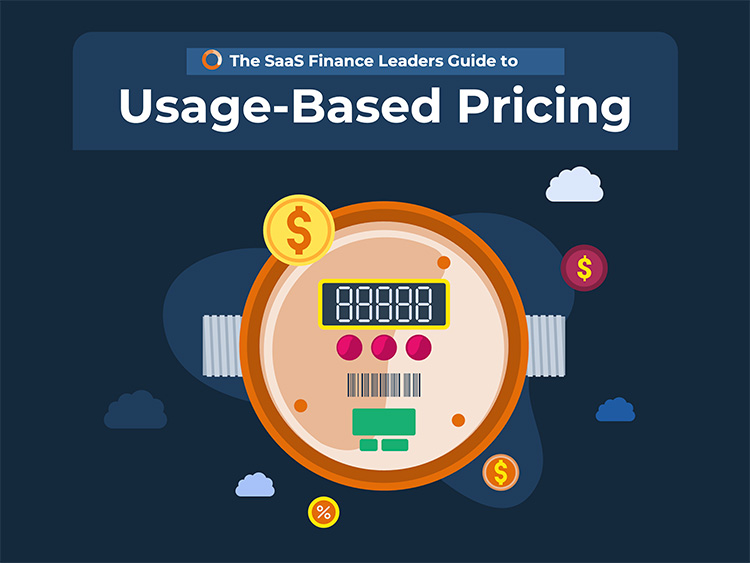Usage-Based Pricing and ARR
Cloud providers that primarily offer usage-based pricing models typically morph ARR into more of a run rate calculation. Usage-based pricing models often do not have the contractually guaranteed, fixed monthly price arrangements of a typical SaaS subscription. The monthly revenue for the majority of customers is calculated in arrears based upon actual consumption. As a result, the revenues generated vary from month-to-month. There may be some customers with a contractual commitment (prepaid usage, monthly minimum, quarterly spend commitment) for which there is a known TCV. However, the dollar amount may not be tied to consumption in a specific month so it is challenging to compute metrics like ARR and Net Revenue Retention for usage-based pricing. Nonetheless, it is useful to monitor the annualized run rate of the providers revenue. The most popular models involve:
- 4 x Trailing 3 months (or 90 days) revenue
- 12 x Trailing month (or 30 days) revenue
Ordway conducted a comprehensive analysis of 150 publicly traded SaaS and cloud providers and identified 10 companies with usage-based pricing report that report on Annual Recurring Revenue (ARR). Included below are the verbatim disclosures related to recurring revenue metrics from their SEC filings (listed in alphabetical order).
Note, that many of the cloud providers best known for usage-based pricing including Amazon.com, Snowflake, Twilio, and Fastly do not report on a recurring revenue metric like ARR.
1) Cloudera
Annualized Recurring Revenue
“Annualized Recurring Revenue (ARR) is the primary metric that management uses to monitor customer retention and growth and to make operational decisions related to our business. ARR equals the annualized value of recurring subscription contracts with active entitlements as of the end of the applicable period. ARR provides a normalized and composite view of customer retention, renewal and expansion as well as growth from new customers, that is a supplement to reported revenue.”
2) Couchbase
ARR
“We define ARR as of a given date as the annualized recurring revenue that we would contractually receive from our customers in the month ending 12 months following such date. Based on historical experience with customers, we assume all contracts will be automatically renewed at the same levels unless we receive notification of non-renewal and are no longer in negotiations prior to the measurement date. ARR excludes revenue from on-demand arrangements and services.”
How Couchbase explains the value of ARR to investors

Couchbase Investor Presentation October 27, 2021
3) DataDog
ARR
“We define ARR as the annual run-rate revenue of subscription agreements from all customers at a point in time. We calculate ARR by taking the monthly run-rate revenue, or MRR, and multiplying it by 12. MRR for each month is calculated by aggregating, for all customers during that month, monthly revenue from committed contractual amounts, additional usage, usage from subscriptions for a committed contractual amount of usage that is delivered as used and monthly subscriptions.”
DataDog uses ARR as a metric to illustrate Product Line Growth

DataDog Investor Presentation October 27, 2021
4) DigitalOcean
ARR
“Given the renewable nature of our business, we view annual run-rate revenue as an important indicator of our current progress towards meeting our revenue targets and projected growth rate going forward. We calculate ARR at a point in time by multiplying the latest monthly period’s revenue by 12.”
From Digital Ocean 10-K for fiscal year ending December 31, 2021
How Public SaaS Companies Report on ARR
Research Analysis of 150 SaaS and Cloud Providers
5) Dynatrace
Annualized Recurring Revenue
“Annual Recurring Revenue “ARR”: We define annual recurring revenue, or ARR, as the daily revenue of all subscription agreements that are actively generating revenue as of the last day of the reporting period multiplied by 365. We exclude from our calculation of ARR any revenues derived from month-to-month agreements and/or product usage overage billings, where customers are billed in arrears based on product usage.”
6) Elastic
Annual Contract Value
“The annual contract value (“ACV”) of a customer’s commitments is calculated based on the terms of that customer’s subscriptions, and represents the total committed annual subscription amount as of the measurement date. Month-to-month subscriptions are not included in the calculation of ACV.”
Elastic shares the count of customers with $10K ACV as key metric

7) Five9
Recurring Revenue
“Our revenue consists of subscription and related usage as well as professional services. We consider our subscription and related usage to be recurring revenue. This recurring revenue includes fixed subscription fees for the delivery and support of our VCC cloud platform, as well as related usage fees. The related usage fees are generally based on the volume of minutes for inbound and outbound client interactions.”
From Five9 10-K for the fiscal year ending December 31, 2021
Usage-Based Pricing
Ordway’s Online Guide
- Volume, tiered, and linear discount models
- Prepaid credits, spend commitments, monthly minimums
8) HashiCorp
ARR
“We define ARR as the annualized value of all recurring subscription contracts with active entitlements as of the end of the applicable period, and in the case of our monthly, or consumption-based customers, the annual value of their last month’s spend.”
From Hashi Corp’s 10-K for the fiscal year ending January 31, 2022
Hashi Corp shares customers with $100K ARR as a key metric

9) MongoDB
Annualized Recurring Revenue
“We calculate annualized recurring revenue (“ARR”) and annualized monthly recurring revenue (“MRR”) to help us measure our subscription revenue performance. ARR includes the revenue we expect to receive from our customers over the following 12 months based on contractual commitments and, in the case of Direct Sales Customers of MongoDB Atlas, by annualizing the prior 90 days of their actual consumption of MongoDB Atlas, assuming no increases or reductions in their subscriptions or usage. For all other customers of our self-serve products, we calculate annualized MRR by annualizing the prior 30 days of their actual consumption of such products, assuming no increases or reductions in usage. ARR and annualized MRR exclude professional services.”
From Sumo Logic 10-K for fiscal year ending January 31, 2022
10) Sumo Logic
Annualized Recurring Revenue Run-Rate
“We define ARR as the annualized recurring revenue run-rate from all customers that are under contract with us at the end of the period or with which we are negotiating a renewal contract. Given our historical experience of customer renewals, if we are in active discussions for a renewal, we continue to include customers with expired contracts in our ARR until the customer either renews its contract or negotiations terminate without renewal. For certain customers whose revenue may fluctuate from month to month based upon their specific contractual arrangements, we calculate ARR using the annualized monthly recurring revenue, or MRR, run-rate (MRR multiplied by 12). This enables us to calculate our anticipated recurring revenue for all customers based on our packaging and licensing models, which we believe provides a more accurate view of our anticipated recurring revenue. “
From Sumo Logic 10-K for fiscal year ending January 31, 2022
Sumo Logic uses ARR to illustrate customer cohort analysis

Learn More about ARR and SaaS Metrics

SaaS Churn Rate Calculation Examples
Frequently asked questions
What is Usage-Based Pricing in Cloud Computing?
Usage-based pricing in cloud computing refers to a model where customers are billed based on their actual consumption of resources rather than a fixed monthly fee. This model allows for more flexibility and can lead to varying monthly revenues for providers.
How Do Cloud Providers Calculate Annual Recurring Revenue (ARR) with Usage-Based Pricing?
Cloud providers often calculate ARR by annualizing recent revenue figures. Common methods include multiplying the trailing three months’ revenue by four or the trailing month’s revenue by twelve to estimate the annualized run rate.
Which Cloud Providers Use Usage-Based Pricing Models?
Some cloud providers known for usage-based pricing models include Cloudera, Couchbase, DataDog, Digital Ocean, Dynatrace, Elastic, Five9, HashiCorp, MongoDB, and Sumo Logic.
Why Do Some Cloud Providers Not Report ARR?
Providers like Amazon.com, Snowflake, Twilio, and Fastly may not report ARR due to the variability in revenue from usage-based pricing models, which can make it challenging to provide a consistent recurring revenue metric.
What Are the Benefits of Monitoring ARR for Cloud Providers?
Monitoring ARR helps cloud providers track customer retention, renewal, and growth. It provides a normalized view of revenue performance, which is crucial for making informed operational and strategic decisions.







